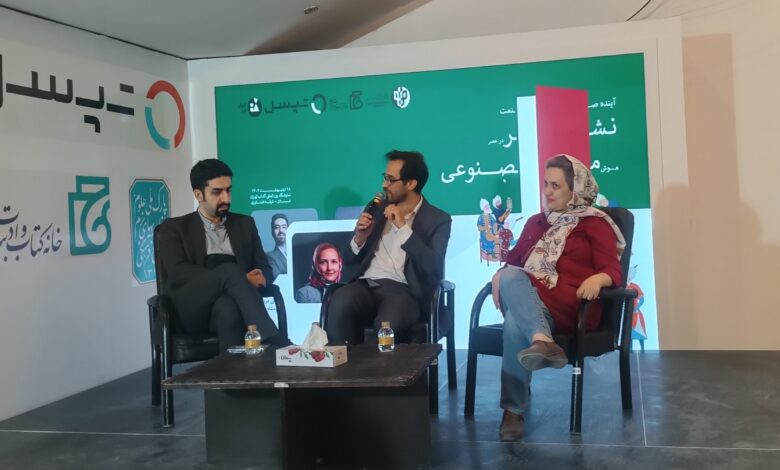The second meeting of the publishing industry in the age of AI was held in the Publishing Technologies Hall at the 36th Tehran International Book Fair. The meeting was attended by Ani Khachikian, founder of the book introduction and review website Vinesh, and Ali Merikhnejad, marketing consultant.
History of the formation of AI
According to Ideaagency, Ani Khachikian in a conversation with Sadegh Attarzadeh said about the history and how AI was formed: “Throughout history, humans have had needs that they faced. For example, in the time of Ibn Sina, there was no industry, everything was traditional, and knowledge was acquired and disseminated slowly and organically. With the first industrial revolution, we no longer needed farmers, but workers, and knowledge gradually changed. With the second industrial revolution, we needed more engineers. Until we reached today. So what can AI do and why was it created? By collecting data from people, it can map the current situation and guide humans by providing study paths.”
Ali Merikhnejad also referred to the impact of production on the formation of AI and said: “Before and after World War I, when production was formed, the vision was to produce better products and make them available. There was no particular variety and choice for the audience, and in practice, instead of variety, mass production was the criterion. Until World War II broke out and a famous saying became popular: “Build a good mousetrap and it will sell itself.”
In the new decade, environmental and social responsibility by brands also became important. Then, in the 1980s and 1990s, the marketing debate became more prominent. In the post-COVID era, we encountered an atmosphere where businesses seemed to be thirsty for the emergence of a new phenomenon.
AI is not just in the book field, but it helps businesses analyze audience behavior and obtain data to provide a product tailored to it. This is a powerful tool because we would have to spend days to achieve this with this tool traditionally.”
Using data-driven AI
Khachikian said of the importance of AI: “Knowledge has clear frameworks. We have a tool that can do work precisely through a process. More importantly, it is someone who uses the tools in a way and with a purpose. From now on, we will think more about why I should read this book or field of study. These purposes can both use the tools better and are more diverse.
She added: “The ecosystems we live in are very complex and their analysis is not that simple. It requires modeling that gradually approaches reality with AI tools. Is it still not 100% achievable? In my opinion, no, the tools are not yet as intelligent as humans. Now, unlike the previous generation, who strengthened the tools of knowledge acquisition, humans have strengthened the tools of asking and reaching needs. Humans can create their own custom paths. We now have human-ordered paths that are achieved with data.”
Data analysis helps the marketing space
Regarding how much data analysis can help publishing in the marketing space to attract valuable books to the audience, Ali Merikhnejad stated: “The printing and publishing industry, as a valuable and old business, has been neglected in recent years. Printed books are slowly fading away, but what is certain is the need for reading books and the acquisition of knowledge in humans, which is why the target market still exists. More user-friendly AI tools, like ChatGPT, can be effective when we give it the right data so that we can use its data in return.
Years ago, when various logo design applications came to the market, everyone said that the work of graphic designers was over, but in fact it benefited graphic designers.
AI should be used as a tool for identifying audience pain points and personal analysis. Experts should be familiar with this tool so that they can use it according to the employer’s goals. Activists from the 70s and 80s need to upgrade their expertise. The older generation also sees themselves as having no need for AI and is not moving towards it.
The consequences of not embracing AI
Ani Khachikian, expressing the consequences of not paying artificial compensation, explained: “Modern slavery means that if people living in society do not prepare themselves for this space and do not enter the realm of social networks, their world will become smaller. What we need to remind ourselves and our families is that the world is a big place and we should try to make our world bigger. Otherwise, if these tools only offer us suggestions, our world will become smaller.
There is a famous saying that goes: We build a house, and our house builds our world. Let us remind ourselves that our choice, which in this day and age is equal to freedom, must be in a position where we can choose. If we are training a machine, we should equip ourselves more, otherwise the machine will eliminate us.”
She added: “There are two types of AI, current and crystallized. Current intelligence innovates, and crystallized intelligence is the experience that makes us do things right. Innovation events weaken crystallized intelligence. We need to do things to increase current intelligence and not fall behind it.”
Using artificial intelligence to analyze customer behavior
Ali Merikhnejad stated: “Our effort in marketing is to limit the access options for the customer because we are faced with customer fatigue, meaning the customer wants to compare and evaluate so much among the options that his mind gets tired. Statistics show that the customer puts off buying in these conditions, and this is considered an upstream goal for business owners.”
He said about the efforts of brands and their relationship with artificial intelligence: “Brands are currently trying to be seen in the output of AI on news sites to be a reference for the GPT chat response for the audience. Because AI primarily asks, for example, what color and what model do you like to limit the response.
If we are among the AI options for the audience, given that the audience’s trust is also related to it, it happens through AI to be seen in the presence of the audience. One of the threats that can exist for businesses, in analyzing the audience’s behavior, is that we do not know exactly what they want. The riskier the product, the heavier it becomes.
Who is the target market for books on using artificial intelligence?
This marketing activist stated: “In the publishing industry, we have several target audiences. In the publishing industry, we need to see who the target market is? Generally, there are students, many of whom are required to read books. There is also a segment of the target market that is at the heart of society and is interested in general books, fiction, or specialized books. This group could be our audience for using artificial intelligence. The threat is that this audience will be misdirected in artificial intelligence, for example, they will search for “What is a good book to read in the field of psychology?” artificial intelligence will take the audience in a direction that is not necessarily useful.
Although this is an opportunity, it is true that per capita reading is low, but Gen Z uses YouTube to learn. I think we need to create a trend in society so that people use artificial intelligence to study. This streamlining will have a positive impact on future book reading, and e-book reading will also develop further. This can be done by industry activists themselves to encourage audiences to purchase books.



No Comment! Be the first one.